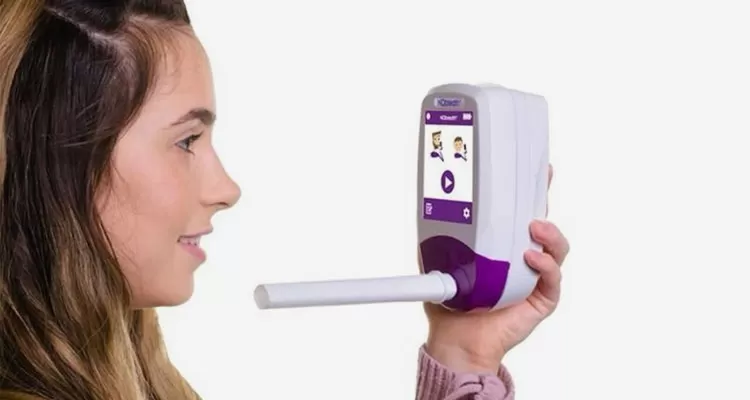The hydrogen breath test is a non-invasive diagnostic tool used to identify gastrointestinal conditions like lactose intolerance, fructose intolerance, or small intestinal bacterial overgrowth (SIBO). It works by measuring hydrogen and methane levels in your breath, which are produced when gut bacteria ferment undigested sugars.
- Conditions diagnosed with hydrogen breath tests
- How hydrogen is generated when one takes sugars like lactose
- How hydrogen breath test is done
- Normal and abnormal hydrogen breath levels
- Hydrogen breath test at home
- Side effects for Hydrogen Breath Test
- Treatment for a positive hydrogen breath test
- Latest news on health hydrogen test
- Latest Research Findings:
- Hydrogen breath test CPT code
- Read about benefits of good nutrition in mid-life
Conditions diagnosed with hydrogen breath tests
Hydrogen breath tests are versatile diagnostic tools used to identify several gastrointestinal conditions, and offer valuable insights into digestive health. These conditions include:
- Lactose Intolerance: Detects malabsorption of lactose (sugar in milk).
- Fructose Intolerance: Identifies issues with fructose absorption. Foods rich in fructose include fruits like apples and mangoes, dried fruits, honey, and processed items such as sugary drinks and sweets.
- Small Intestinal Bacterial Overgrowth (SIBO): Assesses excessive bacteria in the small intestine.
- Carbohydrate Malabsorption: Evaluates the body’s inability to break down or absorb certain sugars.
- Intestinal Transit Disorders (ITD): Measures digestion speed and effectiveness. Examples of ITD include intestinal pseudo-obstruction, Pelvic Dyssynergia, and Hirschsprung’s Disease.
How hydrogen is generated when one takes sugars like lactose
Hydrogen is generated through a process called fermentation when sugars like lactose are not properly absorbed in the small intestine. Here’s how it works:
- Incomplete Digestion: If lactose isn’t broken down due to a deficiency in lactase (the enzyme responsible for digesting lactose), it passes into the large intestine.
- Bacterial Fermentation: Gut bacteria in the large intestine ferment the undigested lactose, producing gases like hydrogen, methane, and carbon dioxide.
- Exhalation: Hydrogen gas is absorbed into the bloodstream, carried to the lungs, and exhaled, which is measured during a hydrogen breath test.
How hydrogen breath test is done
The hydrogen breath test is a simple and non-invasive procedure used to diagnose various gastrointestinal conditions. The test is straightforward and provides valuable insights into digestive health. Here’s how it’s typically done:
Preparation:
- Dietary Restrictions: Avoid high-fiber foods, dairy products, and certain fruits and vegetables for 1-3 days before the test.
- Medication Adjustments: 1 month before, stop antibiotics, probiotics, and laxatives as per your doctor’s instructions.
- Fasting: Do not eat or drink for 12 hours before the test.
- Avoid Smoking and Chewing Gum: Stop 1 week before as these can interfere with the test results.
- Follow Specific Instructions: Your healthcare provider may provide tailored guidelines based on your condition.
Sugar Solution:
You’ll be given a sugar solution to drink. The type of sugar depends on the condition being tested, such as lactose for lactose intolerance or fructose for fructose intolerance. The amount of sugar solution given during a hydrogen breath test depends on the specific sugar being tested for. For example, lactose, fructose, or glucose solutions are commonly used. Typically, the solution contains 25 to 50 grams of sugar. However, the exact quantity may vary based on the test protocol and the individual’s condition.
Breath Samples:
After drinking the solution, you’ll provide breath samples at regular intervals. These samples are analyzed for hydrogen and sometimes methane levels. Typically collected at 15–20-minute intervals over a period of 2 to 3 hours to allow for accurate measurement of hydrogen and methane levels as your body processes the sugar solution.
Analysis:
Elevated levels of hydrogen or methane in your breath indicate issues like bacterial overgrowth or carbohydrate malabsorption.
Normal and abnormal hydrogen breath levels
In a hydrogen breath test, the levels of hydrogen gas in your breath are measured in parts per million (ppm).
- Normal Levels: A baseline hydrogen level of 0-20 ppm is considered normal.
- Abnormal Levels:
- A rise of 20 ppm or more above the baseline within 90 minutes after consuming the test sugar (like lactose or fructose) may indicate conditions such as SIBO or carbohydrate malabsorption.
- Elevated baseline levels might also suggest underlying issues, though this depends on the specific test and preparation.
However, results interpretation is in the context of symptoms and clinical guidelines.
Hydrogen breath test at home
Hydrogen breath tests can be done at home using specialized at-home testing kits. These kits are designed to measure hydrogen levels in your breath after consuming specific sugars, such as lactose or fructose. They are convenient and allow you to perform the test in the comfort of your home, following the same principles as clinical tests.
At-home kits typically include:
- A sugar solution for the test.
- A device to collect and measure breath samples.
- Detailed instructions for preparation and testing.
These kits are particularly useful for individuals with busy schedules or limited access to healthcare facilities. However, it’s essential to follow the instructions carefully to ensure accurate results. If you’re considering an at-home test, consulting with a healthcare provider for guidance is a good idea.
Side effects for Hydrogen Breath Test
The hydrogen breath test is generally safe, but it can cause mild side effects such as bloating, abdominal discomfort, diarrhea, or flatulence. These symptoms are typically related to the sugar solution used during the test and are usually temporary.
Treatment for a positive hydrogen breath test
Treatment depends on the underlying condition. Common approaches include:
- Antibiotics: If the test suggests Small Intestinal Bacterial Overgrowth (SIBO), antibiotics like rifaximin or metronidazole may be prescribed to reduce bacterial overgrowth.
- Dietary Changes: For lactose or fructose intolerance, eliminating or reducing problematic foods can help manage symptoms.
- Probiotics: Some studies suggest that probiotics may help restore gut balance, though their effectiveness varies.
- Elemental Diet: A specialized liquid diet can help starve harmful bacteria while providing essential nutrients.
- Motility Agents: If slow digestion contributes to bacterial overgrowth, medications that improve gut motility may be recommended
Latest news on health hydrogen test
- Diagnostic Uses: Hydrogen breath tests continue to be a reliable tool for diagnosing conditions like lactose intolerance, fructose intolerance, and small intestinal bacterial overgrowth (SIBO). They measure hydrogen and methane levels in the breath to identify digestive issues.
- Preparation and Accuracy: Advances in preparation protocols are improving the accuracy of these tests. Patients are advised to follow strict dietary guidelines before the test to ensure reliable results.
- Research Developments: Studies are exploring the potential of hydrogen breath tests to diagnose motility disorders and other gastrointestinal conditions more effectively.
Latest Research Findings:
- Small Intestinal Bacterial Overgrowth (SIBO)Treatment: A study highlights the effectiveness of holistic approaches, including antibiotics, diet, and supplements, in improving the quality of life for SIBO patients.
- Consensus Guidelines: Research emphasizes the need for standardized protocols for hydrogen and methane breath tests to improve diagnostic accuracy.
- New Diagnostic Tools: Study shows innovations like a four-gas breath test device are enhancing the diagnosis of conditions like IBS and SIBO.
Hydrogen breath test CPT code
The CPT code for a hydrogen breath test is 91065. This code is used for billing purposes and refers to the diagnostic procedure that measures hydrogen or methane levels in the breath to identify gastrointestinal conditions like lactose intolerance, fructose intolerance, or small intestinal bacterial overgrowth (SIBO).

